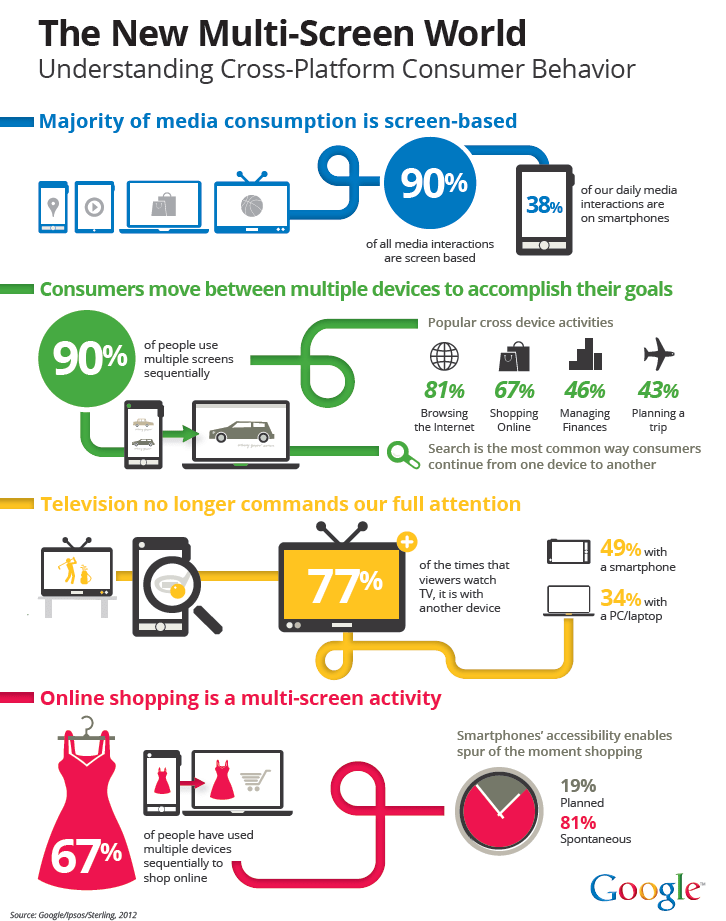Multi Screen Usage & Your Marketing Strategy (Part 1)
How many screens do you use to stay connected and go about your day to day business? I must admit, I’ve entered the realm of multi-screen madness. Whether it’s at work on my laptop, in my car with my iPhone, or lazing around shopping on my tablet, I have a screen that is at least one foot away from me at all times. Sometimes I even find myself even using my iPhone, PC, and watching TV all in one sitting.Talk about crazy, but it’s becoming the norm for a lot of people in today’s digital world. Each screen offers unique purposes and benefits to the end user, making it more important than ever to cater your website and marketing strategies to the way people spend their time and use their devices.
Google published some fantastic research on how people use different screens and devices and how they can be used together. Located below are some of the highlights that will provide you with insight on how you should think about your multi screen marketing strategy.
1. Most of our media time is spent in front of a computer, Smartphone, tablet, or TV. In fact, 90% of all media interactions are screen based, with print and radio at 10%. In order to reach your customers today, now is the time to shift some budget out of radio and print and put more into online. The only question remaining, is which screens do you target, and how?
2. The device/screen we use is based upon where we are, what we want, and the amount of time that is required to assist us with what we are looking for. Now is more important than ever to ensure we are connecting with potential customers on each device in the ways that they are being used.
- Computers keep us informed: task oriented, finding information, keeping up to date. This requires more time and attention (it’s the device you use for work, or do product research to better inform a purchasing decision).
- Smartphones keep us connected: on the go connectivity for entertainment, and communication. This device is important for acquiring information quickly (in the car looking for a store, or waiting in line looking for entertainment).
- Tablets keep us entertained: primarily used at home. This device requires more time with a relaxed leisurely approach (reading, shopping around).
3. Google identifies that there are two types of multi-screening usage: sequential screening and simultaneous screening.
- Sequential Screening: where we move between devices. For example, you are on the bus looking at your emails, see a Groupon for spa services, then you get home and use your laptop to visit the spa website to help you decide whether you want to purchase this Groupon. Overall, 90% use multiple screens sequentially to accomplish a task over time.
- Simultaneous Screening: is when we use multiple devices in one sitting. For example, you might be watching TV and when commercials come on, you might search a product online that triggers your interest or, you flip to your Tablet or Smartphone to go on Facebook.
4. TV no longer consumes our full attention as it is the most common device that is used with another screen. Now is the time to start integrating your TV strategy into online.
5. Depending on where we are and what we need, portable screens like the Smartphone and tablet enable us to easily move from one device to another. Google Search is typically used to bridge this sequential screening, and ensure a fluid transition between devices. This behaviour makes it key to ensure your business shows up in Google Search for phrases relevant to your products and services.
6. During simultaneous usage, most of the time our attention is split between very different activities on each device. For example, I sometimes use my tablet to shop online while simultaneously having conversations with friends on Facebook on my iPhone. For marketers, it’s key to keep your ads, messaging, and website, concise with clear call to actions as the competition for customer attention is at an all time high.
7. Smartphones have the highest user interactions per day and are the most common starting point across multiple screens. Has your business jumped on the mobile band wagon yet? If not, you will be left behind.
8. Multiple screens make us feel more efficient, connected, and entertained by enabling us to maximize our time based upon where we are, what we want, and how much time we have. Think about how you can make your website and marketing strategy unique to each screen device and what your customers need from you when using different devices.
To learn more on how to develop a multi screen marketing strategy, check out my next post coming soon! For more information on this study by Google, you can download the report here.


